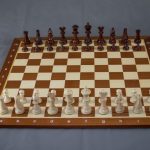Mastering Chess: Strategies for Success
Description
Chess is a two-player strategy board game that has captivated minds for centuries. At its core, the game is played on an 8×8 grid known as a chessboard, where each player commands an army of 16 pieces: one king, one queen, two rooks, two knights, two bishops, and eight pawns. Each piece has its own unique movement capabilities, which dictate how players can maneuver their forces across the board.
The objective is straightforward yet profound: to checkmate the opponent’s king, meaning the king is placed in a position where it cannot escape capture. The game begins with a specific arrangement of pieces, and players alternate turns, moving one piece at a time. The strategic depth of chess lies not only in the movement of pieces but also in the myriad of possible positions that can arise from each move.
Understanding the basic rules is essential, but grasping the underlying principles of control, development, and king safety is what elevates a player from novice to competent. For instance, controlling the center of the board is crucial as it allows for greater mobility and influence over the game. Similarly, developing pieces efficiently—moving them from their starting positions to more active squares—sets the stage for a successful attack or defense.
Key Takeaways
- Understanding the basics of chess is crucial for beginners, including learning the movement of each piece and the objective of the game.
- Developing opening strategies is essential for gaining control of the center of the board and setting the stage for the middle game.
- Mastering the middle game involves understanding pawn structures, piece coordination, and creating a plan to improve the position of your pieces.
- Utilizing endgame tactics is important for converting an advantage into a win, including techniques such as pawn promotion and king activity.
- The importance of positional play cannot be overstated, as it involves controlling key squares, creating weaknesses in the opponent’s position, and maneuvering pieces to optimal squares.
Developing Opening Strategies
Opening strategies in chess are critical as they lay the groundwork for the entire game. The opening phase typically consists of the first ten to fifteen moves, where players aim to establish control over the center, develop their pieces, and ensure king safety through castling. There are numerous established openings, each with its own strategic ideas and variations.
For example, the Ruy Lopez, named after a 16th-century Spanish priest, focuses on controlling the center with pawns while developing knights and bishops to exert pressure on the opponent’s position.
e4 c5. This opening is favored by many aggressive players because it allows Black to counterattack and create imbalances in the position.
The Sicilian Defense leads to rich tactical battles and complex positions that require deep understanding and preparation. Players often memorize various lines within these openings to gain an advantage early in the game. However, it is essential to remain flexible and adapt to the opponent’s responses rather than rigidly adhering to memorized sequences.
Mastering the Middle Game

The middle game is where chess truly comes alive, characterized by complex strategies and tactical skirmishes. After the opening phase, players must transition into this critical stage by evaluating their positions and formulating plans based on piece activity and pawn structure. One of the key aspects of mastering the middle game is recognizing weaknesses in both your own and your opponent’s position.
This could involve identifying poorly placed pieces or vulnerable pawns that can be targeted for attack. Tactics play a significant role during this phase; players must be vigilant for opportunities to execute combinations that can lead to material gain or positional advantages. For instance, a common tactic is the fork, where a single piece attacks two or more enemy pieces simultaneously.
Mastering tactical motifs such as pins, skewers, and discovered attacks can turn the tide of a game in an instant. Additionally, players should be aware of strategic concepts like open files for rooks or outposts for knights, which can provide long-term advantages in controlling key squares on the board.
Utilizing Endgame Tactics
| Endgame Tactics | Metrics |
|---|---|
| Checkmate | 10 |
| Stalemate | 5 |
| Draw | 3 |
| Resignation | 8 |
The endgame is often considered one of the most challenging phases of chess due to its intricate nature and the need for precise calculation. In this stage, fewer pieces remain on the board, which means that every move carries significant weight. Understanding fundamental endgame principles is crucial for converting advantages into victories or salvaging draws from inferior positions.
Key concepts include king activity, pawn promotion, and opposition. One classic example of endgame technique is the concept of “opposition,” where one king directly faces another with an odd number of squares between them. Gaining opposition allows a player to control key squares and ultimately guide their king into a more advantageous position.
Additionally, knowing how to convert a pawn majority into a passed pawn can be decisive; a passed pawn is one that has no opposing pawns blocking its path to promotion. Mastering these endgame techniques requires practice and study, as many games are decided in this final phase.
The Importance of Positional Play
Positional play refers to a style of chess that emphasizes long-term strategic considerations over immediate tactical gains. While tactics can lead to quick victories, understanding positional concepts can provide a more solid foundation for success over time. Key elements of positional play include pawn structure, piece activity, and control of key squares.
A well-structured pawn formation can create strong defensive barriers while also providing avenues for attack. For instance, having pawns on light squares can restrict an opponent’s dark-squared bishop while allowing your own pieces to maneuver freely. Additionally, maintaining control over open files with rooks can create pressure on your opponent’s position and facilitate tactical opportunities later in the game.
Players who excel at positional play often demonstrate patience and foresight, carefully maneuvering their pieces into optimal positions before launching an attack.
Enhancing Tactical Awareness

Tactical awareness is an essential skill for any chess player seeking improvement. It involves recognizing patterns and opportunities that may not be immediately apparent but can lead to significant advantages if exploited correctly. Developing this awareness requires consistent practice and exposure to various tactical puzzles that challenge one’s ability to calculate accurately under time constraints.
Common tactical motifs include forks, pins, skewers, discovered attacks, and double checks. Each of these tactics has its own unique characteristics and applications within different positions. For example, a pin occurs when a piece cannot move without exposing a more valuable piece behind it to capture.
By training regularly with tactical puzzles and analyzing games where tactics played a crucial role, players can sharpen their skills and enhance their overall performance on the board.
The Role of Psychological Warfare in Chess
Chess is not merely a battle of wits; it is also a psychological contest where players must navigate their opponent’s mindset while maintaining their own composure. Psychological warfare can manifest in various forms during a game—bluffing through aggressive play, creating time pressure by playing quickly in critical moments, or even employing unorthodox openings to unsettle an opponent’s preparation. Understanding psychological dynamics can provide an edge in competitive play.
For instance, if a player knows their opponent struggles under time pressure, they might choose to play quickly in critical moments to induce mistakes. Conversely, maintaining a calm demeanor even in challenging positions can prevent opponents from capitalizing on perceived weaknesses.
Analyzing and Learning from Grandmaster Games
One of the most effective ways to improve at chess is by studying games played by grandmasters—players who have reached the highest levels of skill and understanding in the game. Analyzing these games provides valuable insights into advanced strategies, opening choices, and endgame techniques that can be applied in one’s own play. Many grandmaster games are available in databases or books that provide commentary on key moves and ideas.
When studying grandmaster games, it is beneficial to focus on specific themes or concepts rather than merely replaying moves. For example, one might analyze how a grandmaster handled a particular opening or how they transitioned from the middle game into the endgame. By understanding their thought processes and decision-making strategies, players can incorporate these lessons into their own repertoire.
Additionally, reviewing one’s own games alongside grandmaster examples can highlight areas for improvement and inspire new approaches to familiar positions. In conclusion, chess is a multifaceted game that requires a blend of strategic understanding, tactical awareness, psychological insight, and continuous learning from both personal experiences and historical games played by masters of the craft. Each phase of the game presents unique challenges that demand different skills and approaches; thus, aspiring players must cultivate a well-rounded understanding of all aspects of chess to achieve success on the board.
If you’re looking to improve your strategic thinking skills, chess is a great game to play. In fact, studies have shown that playing chess can help improve cognitive abilities and memory. According to a recent article on olxtoto.world, mastering the game of chess can lead to big wins in other areas of life as well. So next time you’re looking for a mental challenge, consider picking up a chess board and honing your skills.
FAQs
What is chess?
Chess is a two-player strategy board game that is played on an 8×8 grid called a chessboard. It is one of the most popular and enduring games in the world, with a rich history dating back over 1500 years.
How is chess played?
Chess is played by two players who take turns moving their pieces on the chessboard. The objective of the game is to checkmate the opponent’s king, which means putting the king into a position where it cannot escape capture.
What are the pieces in chess and how do they move?
The chess pieces consist of the king, queen, rooks, bishops, knights, and pawns. Each piece has its own unique way of moving across the board, and understanding their movements is crucial to playing the game effectively.
What are the basic rules of chess?
Some basic rules of chess include the initial setup of the pieces, the movement of each piece, the concept of check and checkmate, and the rules for capturing opponent’s pieces. Additionally, there are rules for special moves such as castling and pawn promotion.
What are the benefits of playing chess?
Playing chess has been associated with various cognitive benefits, including improved problem-solving skills, enhanced memory, increased concentration, and better decision-making abilities. It is also known to promote strategic thinking and creativity.
Are there different variations of chess?
Yes, there are several variations of chess, including speed chess (blitz and bullet), chess960 (Fischer Random Chess), and team chess (such as bughouse). Each variation has its own unique rules and gameplay, offering different experiences for players.





